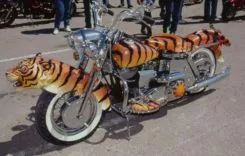Subscriber Technical Questions And Comments – Talk to Us
Check the Oil,
PleaseI just picked up a used ’03 100th Anniversary Road King (my first bike since college, and that was a long time ago). Anyway, I don’t have the owner’s manual, and I wanted to know how to check the oil when the bike is cold. The dipstick only has a mark for hot oil. What gives?Johnny BosticVia e-mail
Johnny,
With the bike on the kickstand and a cold motor, the level of the oil on the dipstick should be approximately halfway between the hot mark and the other indentation below the hot mark. You want to be sure you don’t overfill the system; if you do, it is possible for the system to build up excess pressure and actually blow the dipstick right out of its home. To be sure, it’s best to check the oil once the bike gets up to operating temperature.
We suggest you get yourself a manual from your local Harley dealer. In addition to simple items such as regular maintenance checks, you get lots of great information explaining all the different systems on your bike.
Blink, Blink, Blink
Hey, guys, love the magazine-keep up the good work. The other day I got together with a couple of friends over a few beers, and the discussion led to, of all things, Harley turn signals. We all had our own theory on what caused them to cancel. Can you shed some light on this for us?Thanks!MathewDenver, CO
The systems vary, depending on the year the motorcycle was built. In the case of a late-model H-D, the canceling function is triggered by a series of electronic circuits that combine the functions of a timer and acceleration and deceleration sensors. In the case of a motorcycle in motion, the system processes all the incoming information based on movement (or lack thereof), time, and speed, then tells the turn signals when to shut off. If the bike is stationary (such as sitting at an intersection), the turn signal will continue to flash on and off until the sensors sense the bike’s acceleration. They then tell the turn signals to start the countdown timer to turn-off.
A True Original
I was pleased to see the well-written article about Ron Finch and his many years of motorcycle building. The article took me back in time and made me reminisce over the many years I spent admiring Ron’s work and his artistic application to the custom cycle culture. I spent time hanging out at Ron’s shop on University Avenue, and I remember, as the article recalls, the “Finchmen,” only they were people such as Buda (Doug), Dave, the “Kid,” and others who made the experience of being at Finch’s complete. I’ve never forgotten the bikes such as “Kaleidocycle,” “Trilogy,” and others that were visions only a true builder/artist could imagine and build. Keep in mind, we are talking late ’60s, early ’70s in regard to these incredible futuristic motorcycles. The imaginative paint, overall bike design, and detail on these ’60s and ’70s bikes is ageless, and Ron has always been well ahead of the curve, so to speak-even then.
The article concluded by saying “some have labeled Ron’s work too extreme,” and the writer disagreed; he is right on. I would challenge the bike builders of today to endure more than 40 years of building and still be able to not only bolt a bike together but produce the signature paint work and design that separates this master from the rest even today. Ron is not only a legend but is also still ahead of the curve in motorcycle artistry. He is a master of creativity. I would encourage your readers to visit Ron’s website and see these masterpieces for themselves at www.finchscustoms.com.Thank you,Alan AngerPrinceton, MN
Alan,
Glad you liked the piece; Ron is without a doubt a true original. The man has more talent than most folks will ever dream of possessing. He’s been at it for many years, and we hope to see him around for many more.







